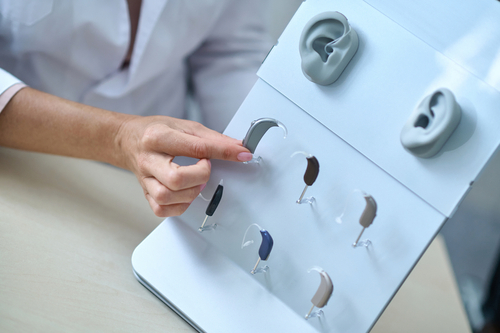From connectivity to deploying the powers of artificial intelligence, the hearing aid sector is booming with innovations to improve your hearing quality.
The journey of hearing aids, from its humble beginnings as an ear trumpet to surgically inserted devices, is filled with constant evolution.
Owing to user demand and a boost in digital hearing technology, modern hearing aids offer hearing assistance and improve user comfort and quality of life.
Advances in hearing evaluations have also increased the need for technology to keep up with what people want from their hearing aids.
This post will look at some of the cutting-edge technologies driving the hearing aid market – and what these exciting developments mean for users.
But First, a Little Hearing Aid History
The ear trumpet took center stage in the assistive hearing department for hundreds of years. The ear trumpet was a tube or funnel-shaped device that took sounds from the outside and directed them into the ear.
A lot has changed since then. Thankfully.
In 1898, the first electronic hearing aid was introduced by Miller Reese Hutchinson. The relatively large invention, the Akoulallion, was later redesigned as a smaller version known as the Akouphone.
But still, the size of the Akouphone made it rather cumbersome for users to carry around wherever they went.
After the introduction of the small electret/FET microphone in the early 1970s, things started to change dramatically for hearing aid technology. This made it possible for hearing aids to shrink in size considerably while still providing improved hearing quality.
What followed was a series of advancements in the digital technology space, which led us to where we are now: hearing aids so developed that they are completely invisible from the outside, such as the Lyric hearing aid, which is the world’s first hearing aid that can be worn around the clock.

Modern Hearing Aids – Modern Features
The technology available in hearing aids of today would indeed surpass what early designers and manufacturers thought was possible. Let’s take a look at some of these hearing tech marvels.
Bluetooth connectivity
In the larger hearing aid models (such as those designed for behind-the-ear placement), the added space allows Bluetooth hardware to be included in the hearing aid body.
This wireless feature lets users connect their hearing aids to other Bluetooth-enabled devices like a laptop or mobile phone.
You can then listen to music, calls, or podcasts in your ear while fully controlling the volume and audio settings.
Improved sound quality and noise cancellation
The introduction of digital signal processing (DSP) technology in hearing aids was a turning point for hearing aid manufacturers. DSP uses advanced algorithms to classify environments according to their noise levels, then adjust your hearing aid to provide an improved hearing experience.
While DSP has been in use since the early 1990s, research into how this technology can further benefit hearing aid users is still ongoing.
Reducing the impact of tinnitus
For those dealing with the symptoms of tinnitus, which can be described simply as a constant ringing in the ears, hearing aids can provide some relief.
Much like how tinnitus-masking devices work, new features in hearing aids deliver a sound on the same frequency level as the ringing. In turn, the unique sound helps hide the constant ringing in tinnitus sufferers.
Data collection to track physical activity and boost health
In the digital age, there is an app for just about any use. The same is true in the hearing aid industry. More and more hearing aids boast the capability to connect to an app on your smart device. The app can then track what the user does, where they go, and the environmental settings they most often find themselves in.
As your hearing affects your overall health, new tech in hearing aids can even monitor your steps, allowing you to keep track of your fitness.
Utilizing AI to improve the hearing experience
Imagine taking a cacophony of sounds, isolating them, and then deciding exactly what you want to listen to in a noisy environment. With AI technology, this could be possible in the near future.
In recent news, Google announced a partnership with Cochlear, the driving force behind Cochlear implants, and a number of other collaborators to use the power of AI in assistive-hearing devices.
The basic idea is for machine learning to analyze your unique hearing condition and tailor your hearing aid to cater to your needs.
Looking Ahead
As technological advancements in the digital sphere give rise to more innovations in the hearing aid industry, we can look forward to hearing aids that do more than just assist with hearing.
At Hearing Associates of Las Vegas, our hearing specialists are constantly upskilling and learning more about the science and technology behind hearing aids to provide advice and expert care on your hearing loss condition.




Leave a Reply